If you are the PR manager for a company that provides financial services, it is important to understand the ins and outs of Financial Public Relations.
Financial PR involves managing public perception of your organization’s financials, operations, products, and personnel in order to help investors and customers to gain confidence in the company. It can involve everything from communications strategy development, to corporate positioning initiatives or even crisis management.
Today, we're going to show you what financial PR is, what its key characteristics are, and how to get started in just a few steps.
If you need a quick and efficient way to find the perfect finance journalist and pitch your story, look no further than Prowly's Media Database. You can enjoy a commitment-free 7-day trial with full access to over 1 million media contacts already in the database, which you can easily filter by keyword, topic, and location.
Why Financial PR is important
On the surface, financial PR can seem vastly different from doing public relations for any other kind of industry.
In reality, the tools and the main goals are the same. The only difference is the audience is made up of brokers, investors, and venture capitalists. Here is why financial PR is important:

Maintaining trust
In the financial industry, trust is crucial. Whether it's the public, your own employees, investors, traders or other stakeholders, building and maintaining trust is everything. Financial services public relations helps you define how each of these audiences perceives your brand or institution.
Crisis management
When disaster strikes, financial PR services help put out the fires. For example, there’s a cybersecurity breach in a financial institution and it seems like all hell is breaking loose. The PR finance team opens up communication with the public to prevent incidents from turning into full-blown crises.
💡 See how real brands handled financial crises–explore these 16 PR crisis management examples to learn what worked (and what didn't).
Attracting investors
If you have a publicly traded company, attracting investors to your business is crucial. Financial PR helps you communicate what your financial performance is like, what your business strategies are, and what growth levers you plan to use for the future. This not only retains existing investors but helps you attract new ones too.
Market positioning
With thoughtful PR financial services, businesses can position themselves as a leader in the market and a lucrative option for potential investors. PR can highlight their strengths and achievements and make their business a desirable investment opportunity.
If you’re looking for a finance journalist, read this article with top reporters in the field, “Top Finance Journalists to Cover Your Story.”
What sets financial PR apart from other industries?
Before going into the differences that make financial PR unique, we need to make one thing clear. While there are some nuances, the tools and methods for dealing with financial PR are the same as in just about any other industry.
Having said that, here is what makes financial PR unique:
The information is more complex
Unlike a company announcing a new CEO or opening up a branch in a new town, financial PR deals with more complex and sensitive information. The audience is highly varied and consists of analysts, investors, and various stakeholders. You need to be able to explain and distill very dense information and this requires substantial knowledge of financial terminology.
Regulatory compliance
Public relations for the finance industry means complying to rules and regulations enforced by bodies such as the Securities and Exchange Commission (SEC) and the Financial Conduct Authority (FCA). To be successful in their jobs, financial PR professionals need to know the legal landscape before putting any information out into the open.
Media scrutiny
The public eye takes a keen interest in financial institutions. This is especially true in times of financial uncertainty and economic downturns. Financial PR professionals need to be ready to be put under a lot of pressure in their day-to-day work.
These guides are here to make choosing a media monitoring tool a breeze. Plus, they'll help you compare prices if you're on the lookout for just the right fit for your PR needs.
Key aspects of financial PR
Here are some of the main aspects of financial PR to keep in mind:
→ Definition and scope: financial events, earnings releases, investor relations, crisis communication, regulatory compliance, mergers and acquisitions
→ Target audience: investors, analysts, employees, shareholders, regulators, the media
There’s a strong connection between financial performance and public perception. Much of the time, the way financial performance is perceived does not depend on the numbers alone, but in the way the numbers are reported. This is where financial PR comes in.
Strategies for financial PR
Here are some of the most common examples of real financial PR strategies.
Example 1: adding some personality to your brand
The finance industry is often perceived as cold and lacking in emotion, even in the face of distress and crises. But it doesn't have to be that way.
With great PR software, you can connect to journalists covering finance news and pitch your stories to show you’re genuine, heartfelt and compassionate. Each press release can be personalized and created for an individual journalist, highlighting your institution's brand and tone of voice.
Example 2: transparency in financial communication
Before journalists can publish articles on your brokerage firm, bank, or other financial institution, beat them to it. Publish the information first, with full transparency in mind: if a crash has hit, explain why and who was affected. Use an online newsroom to publish the information and only then distribute it to journalists by pitching the story.
Example 3: reporting on financial performance to interested parties
Financial performance concerns just about everyone involved in the finance industry. And if you're an investor or a shareholder, you'll be all the more interested in how a company or its stocks are performing.
Financial PR professionals need to report on this performance, usually on a quarterly or annual basis. The same level of financial performance can often be seen as a major win or a big flop, all depending on the angle the PR professional or agency presents it.
This means that as a PR pro, you're in charge of taking the cue from your executives, figuring out what the intended angle is, and reporting on it through different media forms.
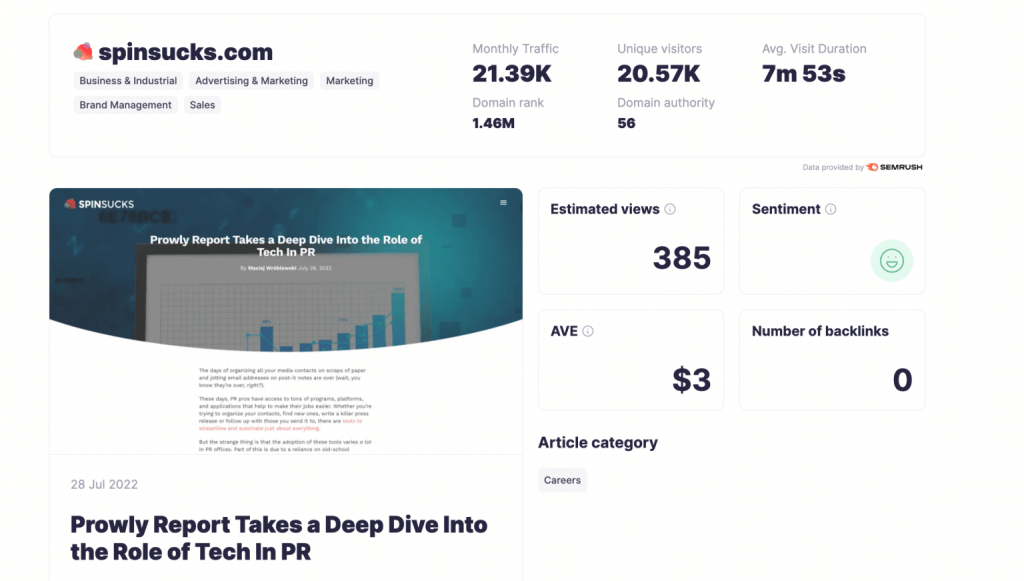
How to do Financial PR: step by step
With Prowly by your side, you get a whole set of tools for public relations that you can use every day. Here are some examples:
Step 1. Find financial journalists
Prowly's media database is a directory of different national or international media contacts that can be sorted based on beat, location, outlet, and other criteria. It has over 1 million contacts that you can browse through.
To illustrate, let's imagine that we are searching for journalists who specialize in "finance."
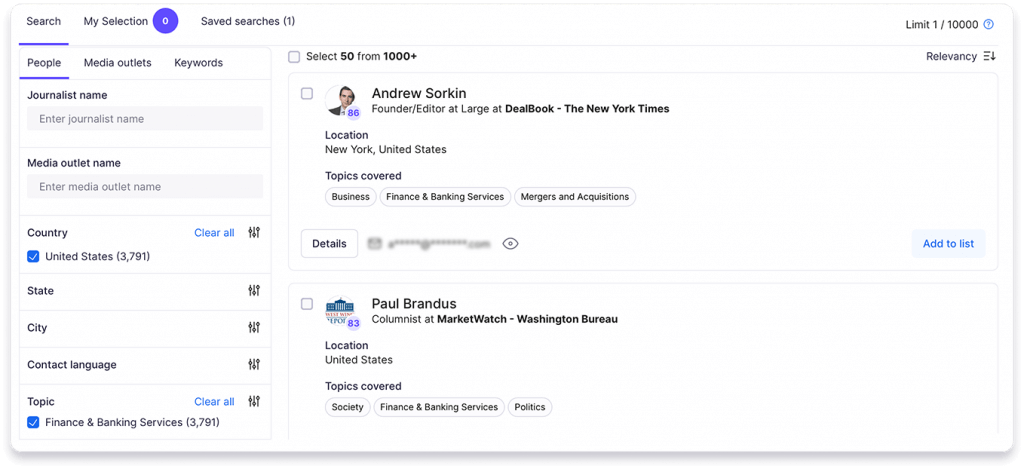
By conducting a swift search, utilizing a tool such as Prowly, you can have an extensive list of journalists, reporters, and media outlets spanning various domains, along with their up to date contact information.
Through Prowly, you also have the capability to search for media contacts based on keywords in their Tweets (X-es) or articles. This enables you to efficiently locate the most relevant reporters and explore their recent works.
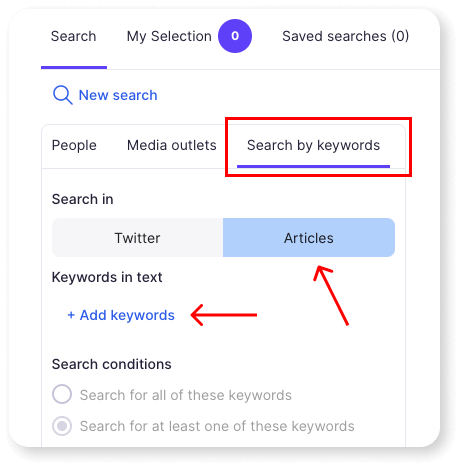
You can further refine your search by utilizing filters, such as specifying a date range, location, or utilizing more advanced filtering options.

After you choose your keywords and filters, you will get a list of journalists who have written articles that align with your search query.

Once you've found the right financial journalist, according to your criteria, you can use Prowly to send a personalized pitch. You can filter the database to find journalists who are the most likely to cover your story based on their past publications.
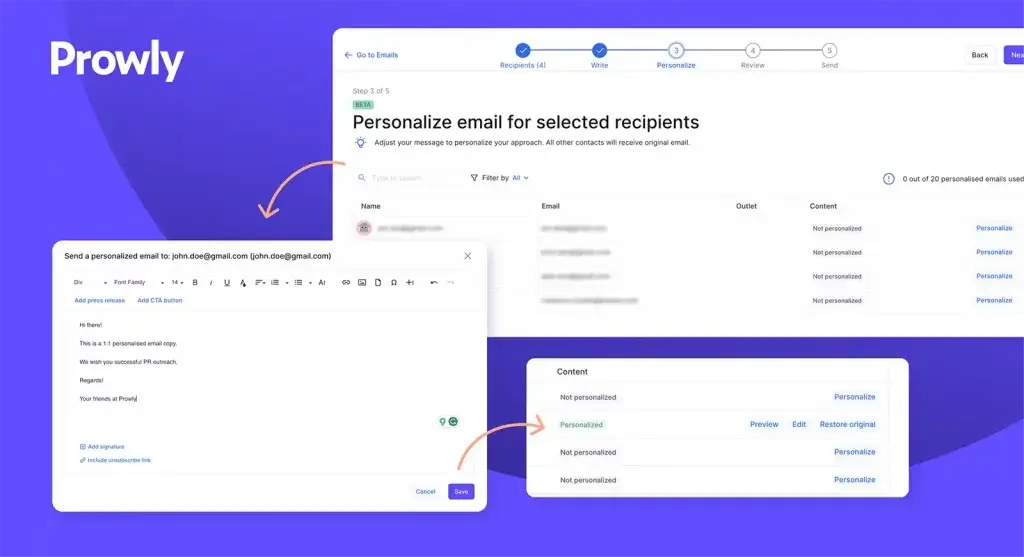
Read more about how to find the right journalist for your finance story in the following article “How to Find Relevant Journalists & Their Emails to Contact Them.”
Step 2. Writing financial press releases (with the help of AI)
Once you've found a journalist who could cover your story, you don't have to face an empty document. Prowly's AI enhanced PR software helps you get around writer's block by asking you questions about the kind of press release you want to create.
Once the tool is finished with its prompts, it gives you an almost-finished press release written with AI. Make a few tweaks and fill in the critical details, hit send and you're off to the races.
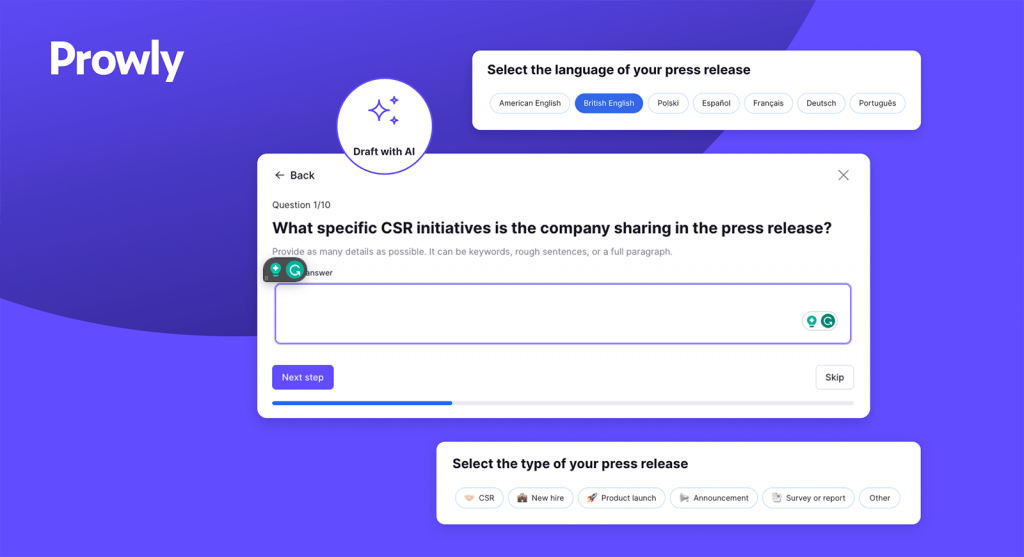
Step 3. Monitor the web and social media for specific terms
If you want to nail finance PR, you need to stay on top of whose writing about specific terms, businesses and individuals. For example, you may want to see when someone mentions the Dow Jones Industrial Average (DJIA).
You can use Prowly's media monitoring tool and add the "dow jones industrial average" and "djia" as keywords. Every time someone mentions them, you'll get a notification in the Prowly dashboard. Alternatively (or additionally), you can receive daily or weekly emails with all of your mentions in one place.
This allows you to stay on top of the latest financial public relations trends around particular topics, businesses and people.

Step 4. Create an online newsroom for your brand or institution
Whether you work with a commercial bank or a brokerage firm, it can be hard battling fake news and updates about these businesses. When you're helping them with financial PR, create an online newsroom on their websites.
Prowly's Online Newsroom feature lets you do that - create a section on the website that is dedicated to sharing news and updates about the brand. With just a few clicks, you can adapt the newsroom into your website's design.
When journalists want to publish a story from PR for financial services, they won't have to go to third-party sources to cover your business. All the info will be there on your clients' websites.
Conclusion
While financial PR can be incredibly challenging, it's nothing like impossible. With the right information and education, and a good set of PR tools by your side, finance PR is not much different than doing PR for a software startup or a fashion company.
And to make sure you feel comfortable navigating the PR landscape, you need a good set of tools. With Prowly, you can do it all - from finding journalists, to creating PR releases and performing media monitoring on your most important terms.
Grab your free trial of Prowly today and become a financial PR pro!

